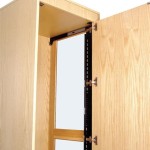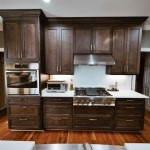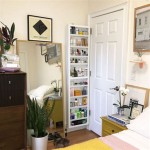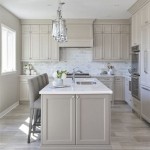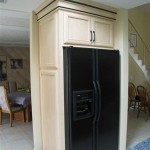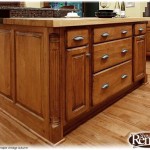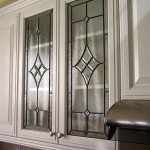Do You Have To Prime Kitchen Cabinets Before Painting Them?
The question of whether to prime kitchen cabinets before painting is a frequently debated topic among homeowners and painting professionals alike. While it might seem like an unnecessary step, adding time and cost to the project, priming offers significant benefits that contribute to a more durable and aesthetically pleasing finish. The decision to prime depends on several factors, including the cabinet material, the existing finish, and the type of paint being used.
Priming acts as an intermediary layer between the cabinet surface and the paint. It prepares the surface for optimal paint adhesion, blocks stains from bleeding through, and creates a uniform base for consistent color application. Skipping the priming stage can lead to issues such as poor paint adhesion, uneven color distribution, and a shorter lifespan for the paint job. Conversely, proper priming ensures the paint adheres correctly, the color remains vibrant, and the finish resists chipping and peeling for a longer period.
Understanding the purpose and benefits of priming is crucial in determining whether it is a necessary step for your specific kitchen cabinet painting project. Careful consideration of the factors influencing the need for priming can lead to a successful and long-lasting paint job.
Understanding the Benefits of Priming Kitchen Cabinets
Priming kitchen cabinets goes beyond simply adding another layer of coating. It provides a range of benefits that directly impact the quality, longevity, and aesthetic appeal of the final paint job. These benefits address common issues encountered during cabinet painting and contribute to a professional-looking outcome.
Improved Adhesion: One of the primary purposes of primer is to create a surface that paint can effectively adhere to. Many kitchen cabinet materials, such as laminate or glossy wood, have smooth, non-porous surfaces that prevent paint from properly bonding. Primer creates a slightly textured surface that enhances paint adhesion, preventing peeling, chipping, and blistering. Without a primer, the paint might sit on the surface without properly bonding, leading to premature failure.
Stain Blocking: Kitchen cabinets are often exposed to grease, food splatters, and other stains that can seep into the wood or laminate. These stains can bleed through the paint, discoloring the finish and requiring multiple coats for adequate coverage. Primer acts as a barrier, preventing existing stains from migrating to the surface of the paint. Stain-blocking primers are specifically formulated to seal in stains and prevent them from reappearing, ensuring a clean and uniform finish.
Uniform Surface: Kitchen cabinets can have variations in color and porosity, especially if they have been previously painted or have undergone repairs. These variations can cause the paint to absorb unevenly, resulting in an inconsistent color finish. Primer creates a uniform base, neutralizing the underlying color differences and providing a consistent surface for the paint to adhere to. This ensures that the paint color appears true and even across all cabinet surfaces.
Sealing Porous Surfaces: Some cabinet materials, such as raw wood or MDF (Medium-Density Fiberboard), are highly porous, meaning they readily absorb liquids. When paint is applied directly to these surfaces, it gets soaked up quickly, requiring multiple coats to achieve adequate coverage. Primer seals the pores, reducing the absorbency of the surface and preventing excessive paint absorption. This not only saves paint but also ensures a smoother and more uniform finish.
Enhanced Durability: By improving adhesion and sealing porous surfaces, primer contributes to the overall durability of the paint job. The paint is less likely to chip, peel, or scratch, extending the life of the finish. A properly primed surface provides a solid foundation for the paint, allowing it to better withstand daily wear and tear.
Factors That Determine the Need for Priming
The decision to prime kitchen cabinets should not be arbitrary. Several factors must be considered to determine whether priming is necessary for a successful and long-lasting paint job. These factors include the cabinet material, the existing finish, and the type of paint selected.
Cabinet Material: The material of the kitchen cabinets plays a significant role in determining the need for priming. Different materials have different levels of porosity and surface characteristics that affect paint adhesion. Raw wood cabinets, particularly those made of porous woods like oak or pine, require priming to seal the pores and prevent excessive paint absorption. MDF cabinets also benefit from priming due to their porous nature. Conversely, laminate or melamine cabinets have a smooth, non-porous surface that requires a specialized bonding primer to ensure adequate paint adhesion. Metal cabinets also require priming to prevent rust and promote paint adhesion. Consider using a rust-inhibiting primer for metal surfaces.
Existing Finish: The condition and type of the existing finish on the kitchen cabinets also influence the need for priming. If the cabinets have a glossy or high-shine finish, such as lacquer or varnish, the surface must be properly prepared to ensure paint adhesion. Sanding the surface to create a rougher texture is essential, but priming with a bonding primer is also recommended to further enhance adhesion. If the existing finish is peeling, chipping, or damaged, it must be thoroughly repaired and sanded before priming. Cabinets with existing stains or discoloration require a stain-blocking primer to prevent these imperfections from bleeding through the new paint.
Type of Paint: The type of paint being used on the kitchen cabinets also affects the priming decision. While some paints are marketed as "paint and primer in one," they may not provide adequate adhesion or stain-blocking capabilities for all surfaces. In general, it is advisable to use a separate primer, especially when painting over glossy or non-porous surfaces, or when dealing with cabinets that have existing stains or discoloration. When using oil-based paints, it is crucial to use an oil-based primer to ensure compatibility and proper adhesion. Similarly, when using latex or acrylic paints, a latex or acrylic primer is recommended. The primer and paint should be compatible to prevent issues such as peeling, cracking, or blistering.
Color Change: A drastic color change also indicates the need for priming. Painting a light color over a dark color, or vice versa, can require multiple coats of paint to achieve full coverage. Primer helps to block the underlying color and creates a neutral base for the new color, reducing the number of paint coats required and saving time and money.
Selecting the Right Primer for Kitchen Cabinets
Choosing the right primer is just as important as choosing the right paint. The primer should be compatible with both the cabinet material and the type of paint being used. Different types of primers offer different properties and are suited for specific applications.
Oil-Based Primers: Oil-based primers are known for their excellent adhesion, stain-blocking capabilities, and ability to seal porous surfaces. They are particularly effective for raw wood cabinets and cabinets with existing stains or discoloration. However, oil-based primers have a longer drying time and require mineral spirits for cleanup. They are also less environmentally friendly than water-based primers.
Latex Primers: Latex primers are water-based and offer good adhesion, stain-blocking capabilities, and sealing properties. They are easier to apply and clean up than oil-based primers and are more environmentally friendly. Latex primers are suitable for most cabinet materials, including raw wood, MDF, and previously painted surfaces. However, they may not be as effective as oil-based primers for blocking stubborn stains or sealing highly porous surfaces.
Acrylic Primers: Acrylic primers are another type of water-based primer that offers excellent adhesion, flexibility, and durability. They are particularly well-suited for cabinets that are subject to expansion and contraction due to temperature and humidity changes. Acrylic primers are also resistant to cracking and peeling, making them a good choice for cabinets in high-moisture environments.
Bonding Primers: Bonding primers are specifically formulated to adhere to smooth, non-porous surfaces, such as laminate, melamine, and glossy finishes. They contain special additives that create a strong bond between the primer and the surface, ensuring adequate paint adhesion. Bonding primers are essential for painting these types of cabinets.
Stain-Blocking Primers: Stain-blocking primers are designed to prevent stains from bleeding through the paint. They contain pigments and additives that seal in stains and prevent them from migrating to the surface. Stain-blocking primers are available in both oil-based and water-based formulas.
Application Considerations: Regardless of the type of primer chosen, proper application is crucial for achieving the desired results. The surface should be clean, dry, and free of dust and debris before applying the primer. Apply the primer in thin, even coats, following the manufacturer's instructions. Allow the primer to dry completely before applying the paint.
In summary, while not always mandatory, priming kitchen cabinets before painting is highly recommended in most situations. The benefits of improved adhesion, stain blocking, uniform surface creation, and enhanced durability far outweigh the additional time and cost involved. By carefully considering the cabinet material, existing finish, and type of paint being used, and by selecting the appropriate primer, homeowners can achieve a professional-looking and long-lasting paint job for their kitchen cabinets.

What You Need To Know Before Painting Cabinets The Palette Muse

How To Prime Cabinets For A Smooth Finish The Turquoise Home

How To Paint Kitchen Cabinets A Step By Guide Confessions Of Serial Do It Yourselfer

Refinish Kitchen Cabinets With Kilz Restoration Primer

How To Paint Your Kitchen Cabinets In 37 Easy Steps 2 Cabinet Girls

The Best Way To Paint Kitchen Cabinets No Sanding Palette Muse

A Step By Guide To Painting Kitchen Cabinets With Kilz Primer Blog

How To Paint Laminate Cabinets Without Sanding The Palette Muse

Avoid These Mistakes How To Paint Cabinets That Are Already Painted Grace In My Space

Diy Painting Your Kitchen Cabinets The Right Way
Related Posts

